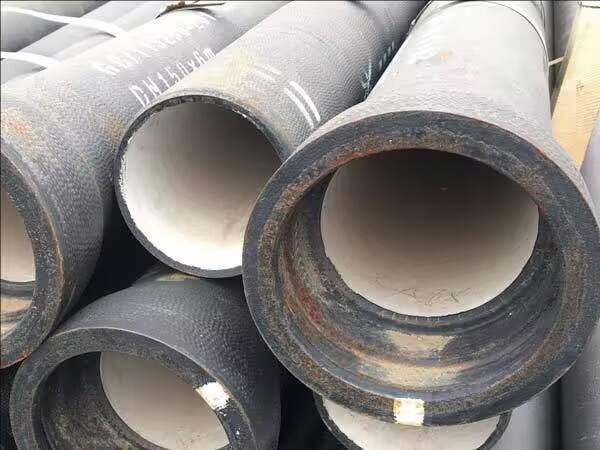Cement lined carbon steel pipe refers to the coating or centrifugal pouring of a layer of cement mortar inside the carbon steel matrix (such as standard pipes like ASTM A53, A106 or API 5L, etc.), and the formation of a protective layer after curing and solidification. This lining is widely used in water supply, seawater, wastewater, fire protection and chemical circulating water systems.
1. Structure and Principle
Cement lined carbon steel pipe is composed of carbon steel matrix and internal cement mortar lining. Carbon steel pipes provide mechanical strength. The cement layer (usually 3-6mm thick) acts as an isolation barrier to prevent the conveyed medium (such as water) from coming into direct contact with the steel pipe, thereby inhibiting electrochemical corrosion and extending the service life of the pipeline.
Carbon steel matrix: The matrix of carbon steel pipes usually adopts seamless or welded steel pipes, such as ASTM A53/A106,
API 5L, AWWA C200 series. The material yield strength is 240-360 MPa, and the wall thickness is implemented in accordance with the ANSI B36.10 standard.
Lining material: High-strength cement mortar is used for the inner lining. Generally, hydrochloric acid resistant cement or ordinary Portland cement is selected in combination with graded fine aggregates. The water-cement ratio is controlled at 0.40-0.50 to ensure low porosity and high density.

2. Lining process
Centrifugal method: High slump mortar is pumped into a rotating tube. Through centrifugal force, the mortar is evenly distributed along the inner wall of the tube, and the excess water is squeezed out to form an initial setting layer. Then it is left to stand and cure for more than 4 days to reach the designed strength.
Static pressure method/spraying method: For large pipe fittings or on-site repairs, spraying or manual plastering can be adopted. Maintenance should be carried out in a well-ventilated and constant-temperature environment.
Curing: Cure in a high-temperature and high-humidity environment to ensure that the cement layer is dense and free of cracks.
Inspection: Use ultrasound or visual inspection to check the integrity of the lining.
3. Performance characteristics
Corrosion resistance: It can effectively resist chloride ions and acidic substances in water and soil, and has a long service life, usually over 50 years.
Environmentally safe: Compliant with ANSI/NSF 61 drinking water safety standard, suitable for drinking water systems such as municipal water supply, etc.
Economy: The cost is lower than that of stainless steel or epoxy-coated steel pipes, making it suitable for large-scale projects.
High mechanical strength: The compressive strength of the lining can reach 20-40 mpa, and it has excellent crack resistance.
4. limitation
Mechanical strength: The cement layer is brittle and vulnerable to shock or sudden temperature changes (>60℃).
Weight increase: 10-20% heavier than ordinary carbon steel pipes, raising transportation and installation costs.
Maintenance requirements: Regular endoscopic inspection is required, and special repair materials are required for local damage.
5. Typical application scenarios
Municipal water supply and distribution main pipeline
Thermal power generation and cooling circulating water system
Seawater intake and offshore platform
Wastewater, sewage and chemical discharge lines
Fire water network and high-rise building domestic water supply
6. Relevant standard
ANSI/AWWA C205:400 mm Cement mortar linings and coatings for steel pipe works and above.
ANSI/AWWA C602: Specification for field construction of cement mortar linings for piping systems.
AWWA Manual M11: Steel pipe design and installation guide.
AS 1281 (Australia) : Requirements for thickness of cement mortar lining.
ISO 4179: Corrosion protection and lining of pipelines.
CENTRAL STEEL is a well-known supplier of cement lining pipes in China. We can provide cement lined carbon steel pipes of various grades and standards, in compliance with international norms such as ASTM, AWWA, ISO, DIN, etc. Our product range is complete and suitable for municipal water supply, sewage treatment, fire protection pipe networks, industrial fluid transportation and other projects. With stable quality, reasonable prices and punctual delivery, Sinosteel has become a trusted partner for domestic and foreign customers.
Summary
Cement-lined carbon steel pipes are an economical anti-corrosion solution, especially suitable for medium and low pressure, normal temperature water transmission scenarios. In projects with limited budgets and controllable corrosion risks, its cost performance is remarkable. However, in harsh environments (high temperatures, strong corrosion), higher-order materials (such as duplex stainless steel or lined steel pipes) should be selected.
Read more : Carbon steel seamless pipe supplier in China
